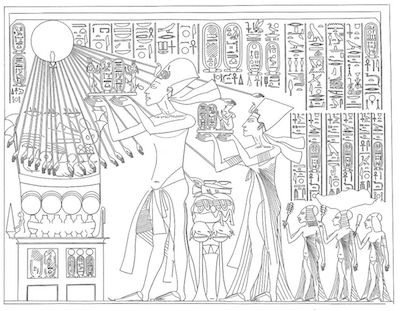

Resources for Schools
Welcome to the Life in Ancient Egypt: Amarna web pages dedicated to children (ages 7 – 11), teachers and schools. Here you will uncover a time capsule of ancient Egyptian daily life at the archaeological site of Amarna from the time of the Pharaoh Akhenaten and find insights into fascinating stories linked to the archaeology of Amarna. Explore our free resources to access information, activity worksheets and films. If you're a primary school teacher, we'd also love to hear your insight and feedback about the learning resources you need to teach ancient Egypt.
Amarna was once a great city. Today it is the home of communities who lead modern lives around the ancient ruins.

What and where is Amarna?
Amarna (Tell el-Amarna) can be found on the east bank of the river Nile about half way between Egypt’s capital city of Cairo in the north and Luxor in the south. More than 25,000 people live around Amarna today in the three towns of Tell Beni Amran (El-Till), El-Hagg Qandil, and El-Ammariyya. Many of the families have lived in the area for generations. While the three towns are rapidly growing modern settlements, the remains of the ancient city still shape many aspects of 21st Century life. From driving along the same road once used by Akhenaten and the chariots of his entourage to looking across the ruins of the ancient site towards the imposing desert cliffs, there are many clues that tell us about a time when Amarna was the most important city in all of Egypt.

3300 years ago Amarna had a different name: Akhetaten. Akhetaten means ‘Horizon of the Sun Disc’ in ancient Egyptian: the mountain sign is the horizon (Akhet) and the signs to the right spell Aten (the sun).

The pharaoh Akhenaten ordered the city to be built. At Akhetaten he started the world’s first recorded religion to focus on just one god, a sun god, the Aten. There were no temples of festivals for any other gods at Akhetaten. Was the pharaoh an idealist, individualist or despot? Views on Akhenaten today are diverse. Regardless, his reign was a momentous episode in Egyptian history and one that still challenges us today to consider the world around us.
People came from all over Egypt to build the new city out of mudbrick and stone: sculptors, scribes, builders, farmers, administrators and craftspeople were all needed.

Akhenaten’s wife, Nefertiti, and his family also moved to the new city of Akhetaten to support the king.
Life in the city was focused on the worship of the sun god Aten. Huge open-air temples with beautiful sculptures and eye-catching art formed the heart of the city. It was a busy place and an enormous amount of work went into preparing offerings to the sun god at the temples. In a very short time, palaces, workshops, tombs, roads, cemeteries and thousands of houses also sprang up alongside the temples.
A huge amount of labour went into building Akhetaten, but after less than twenty years the city was abandoned. Once Akhenaten died, the kings of Egypt went back to worshipping many different gods and tried to erase all traces of Akhenaten’s rule. Stone from the city of the sun god was taken to other places like Khemenu (modern El-Ashmunein) for reuse and everything began to fall into ruin.
Despite this, much of Akhetaten survived. It is, in fact, the best-preserved city from ancient Egypt and a sort of time capsule of life 3300 years ago. Today, archaeological research allows us to discover a huge amount about this ancient place and the lives of the people who lived there.


Funder
British Council


